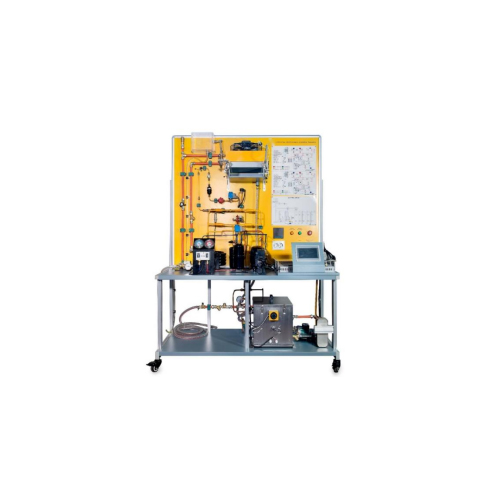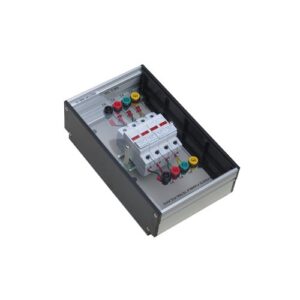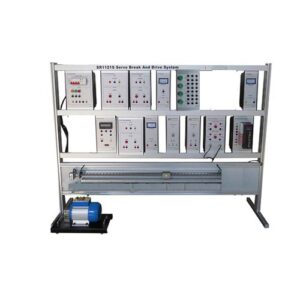ATB20230308R-011 Computer Controlled Geothermal (Low Enthalpy) Energy with Software
Computer Controlled Geothermal (Low Enthalpy) Energy with Software Features:
– The Computer Controlled Geothermal Unit is designed to study and understand of geothermal energy using a geothermal heat pump system for heating and or cooling.
– The trainer comes with an aluminium frame which accommodates the modules and also easy movement suitable for demonstration purpose.
– The component modules are made from high quality material with Laser engraving technology system where the components symbol are show.
– The connections between components are made by safety test lead in 4mm system.
Specification:
- Main Part:
Unit mounted in aluminum frame and panels of painted steel. The unit includes wheels to facilitate its mobility. Main metallic elements made of stainless steel.
Diagram in the front panel with distribution of the elements similar to the real one.
Heat pump:
Hermetic compressor: Power: max. 0.5 CV, 4 A.
Coefficient of performance: approx. 1111 W at 0 ºC. Power measurement from the computer.
Two water condensers/evaporators, depending on heating or cooling configuration (winter or summer conditions), by using the cycle inversion valve:
Capacity: min. 1580 W. Consumption: min. 170 l/h. Computer controlled air condenser/evaporator, depe ing on heating or cooling configuration (winter or summer conditions), by the cycle inversion valve:
Maximum air flow: 980 m³/h. Coefficient of performance: 1591 W at 5 ºC. High pressure control: 8 – 32 bar.
Coolant storage tank.
Refrigerant filter.
Refrigerant separation tank. Expansion valve.
Four way-valve (cycle inversion valve) – solenoid valve. Four “J” type temperature sensors for the refrigerant circuit.
Two “J” type temperature sensors for the air temperature measurement. Two pressure sensors for the refrigerant circuit:
sure, range: 0 – 25 bar. Low pressure, range: 0 – 10 bar. Four manometers for the refrigerant circuit. Refrigerant flow sensor, range: 5 – 60 l/h.
Sanitary water circuit:
Water tank. Capacity: min. 130 l. Water pump.
Water flow or to measure water flow, range: 0.25 – 6.5 l/min. Three “J” type temperature sensors for the water temperature.
Geothermal exchanger simulator: Water heat exchanger: A pipe system inside a water bath (at constant temperature). Three “J” type temperature sensors for the water temperature.
Water pump to Circulate from the pipe System located inside the bath (to simulate the ground loop).
Work in opened and closed loop by valves selection. Chilling unit to maintain constant temperature in the water bath:
, approx. 1460 W. Optimum water flow: approx. 3000 –
6000 l/h.
Water pump, to send the water from the chilling unit to the water bath. Two “J” type temperature sensors for the water temperature.
Water flow sensor to measure water flow, range: approx.
0.25 – 6.5 l/min.
Enthalpy diagram of the refrigerant AR134a. The complete unit includes as well:
Advanced Real-Time SCADA.
Interface box with process diagram in the front panel. The unit control elements are permanently computer controlled.
Simultaneous visualization in the computer of all parameters involved in the process. Calibration of all sensors involved in the process.
Real time curves representation about system responses. All the actuators’ values can be changed at any time from the keyboard allowing the analysis about curves and responses of the whole process.
Shield and filtered signals to avoid external interferences. Real time computer control with flexibility of modifications from the computer keyboard of the parameters, at any moment during the process.
Real time computer control for parameters involved in the process simultaneously.
Open control allowing modifications, at any moment and in real time, of parameters involved in the process simultaneously.
Three safety levels, one mechanical in the unit, another electronic in the control interface and the third one in the control software.
– Data Acquisition Board:
The Data Acquisition board is part of the SCADA system.
Compatible with the industry standards.
Flexible, open and multicontrol software, developed with actual windows graphic systems, acting simultaneously on all process parameters.
Management, processing, comparison and storage of data. Sampling velocity up to 250 KS/s (kilo samples per second). Calibration system for the sensors involved in the process. It allows the registration of the alarms state and the graphic representation in real time. Open software, allowing the teacher to modify texts, instructions. Teacher’s and student’s passwords to facilitate the teacher’s control on the student, and allowing the access to different work levels.
This unit allows the min. 30 students of the classroom to visualize simultaneously all the
results and the manipulation of the unit, during the process, by using a projector or an electronic whiteboard.
– Cables and Accessories, for normal operation.
– Manuals:
This unit is supplied with 8 manuals: Required Services, Assembly and Installation,
Interface and Control Software, Starting-up, Safety, Maintenance, Calibration & Practices Manuals.
EXERCISES AND PRACTICAL POSSIBILITIES TO BE DONE WITH THE MAIN ITEMS
1.- Study of geothermal energy using a geothermal heat pump system for heating or cooling.
2.- Study of the system with different ground temperatures.
3.- Determination of the inlet power, produced heat and coefficient of performance, working in heating mode.
Water-water heat pump.
4.- Determination of the inlet power, produced heat and coefficient of performance,
working in cooling mode. Water-water heat pump.
5.- Determination of the inlet power and valuation of the air temperatures, working in heating mode. Water-air heat pump.
6.- Determination of the inlet power and valuation of the air temperature, working in cooling mode. Water-air heat pump.
7.- Preparation of performance curves of the heat pump, working in heating mode, with different inlet and outlet temperatures. Waterwater heat pump.
8.- Preparation of performance curves of the heat pump, working in cooling mode, with different inlet and outlet temperatures. Waterwater heat pump.
9.- Lay out of the steam compression cycle in a P-H diagram and comparison with the ideal cycle. Water-water heat pump. Heating mode.
10.- Lay out of the steam compression cycle in a P-H diagram and comparison with the ideal cycle. Water-air heat pump. Heating mode.
11.- Preparation of the performance curves of the heat pump based on the properties of the refrigerant and at different condensation and evaporation temperatures. Water-water heat pump. Heating mode.
12.- Preparation of the performance curves of the heat pump based on the properties of the refrigerant and at different condensation and evaporation temperatures. Water-water heat pump. Cooling mode.
Additional practical possibilities: 13.- Sensors calibration.
Other possibilities to be done with this Unit: udents view results simultaneously.
To view all results in real time in the classroom by means of a projector or an electronic whiteboard.
15.- Open Control, Multicontrol and Real Time Control. This unit allows intrinsically and/or extrinsically to change the span, gains; proportional, integral, derivative parameters; etc, in real time.
16.- The Computer Control System with SCADA allows a real industrial simulation.
17.- This unit is totally safe as uses mechanical, electrical/electronic, and so tware safety devices. 18.- This unit can be used for doing applied research.
19.- This unit can be used for giving training courses to Industries even to other Technical Education Institutions. 20.- Control of the unit process through the control interface box without the computer. 21.- Visualization of all the sensors values used in the unit process.
– By using PLC-PI additional 19 more exercises can be done.
– Several other exercises can be done and designed by the user.
Supplied including: Supplied Including:
– 1 unit Personal Computer (PC):
- Processor : min. AI5
- RAM : min. 8GB
- SSD : min. 240GB
- DVD RW
- VGA : min. Nvidia 2GB
- Display : 19″
- OS : Windows 10
- including keyboard and mouse
– Standard Accessories











